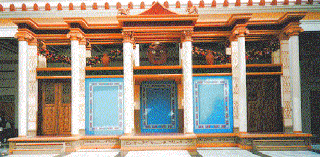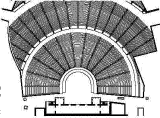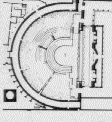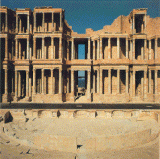Introduction to Roman Stagecraft
Roman drama has several origins, some native to Italy, some imported. One of the most important influences on Roman Comedy (called the fabula palliata in Latin, after the 'Greek' cloak or pallium worn by the actors) was the Atellan Farce, a non-scripted theatrical form which made use of stock masks (characters) and slapstick gags. It was very similar to the Commedia dell'arte of the Italian Renaissance.
These slapstick characters and pratfalls were welded onto the tradition of Greek New Comedy, which was imported into Rome after its conquest of Greece. New Comedy is the ancestor of sitcoms, with plots focusing on domestic issues, usually involving boy-meets-girl-parents-forbid-marriage and the intervention of a clever slave to save the day. The Greek versions were fairly genteel, but Plautus and the other early Roman comic playwrights added lively action, ferocious puns (in Latin and Greek), rude jokes, and lots and lots of physical comedy.
The actors of Roman comedy were all men, and about five of them shared out all the different roles in the play. The costumes were fairly simple, consisting of a tunic and a pallium, which was long for female characters and short for male characters. The actors also wore masks, which were wildly distorted stereotypes, not very realistic, but funny.
These plays were performed at religious festivals sponsored by junior officials in the Roman government. The audience was clearly rowdy, and drama competed for audience attention with tightrope walkers, jugglers, and gladiatorial combats.
Permanent stone theaters were forbidden in the city of Rome itself by the uptight Roman government, so the plays of Plautus and Terence were performed on temporary wooden stages like this one, used for performances at the J. Paul Getty Museum in Malibu, CA, October 1994. The design is based on theatrical wall paintings from Rome, Pompeii, and Oplontis, a good discussion of which can be found in Beacham, R.C., The Roman Theatre and its Audience, Harvard University Press (Routledge in the UK), 1991.

The Romans also produced tragedies, and these were more straightforward translations and adaptations of the Greek plays of the 5th and 4th centuries BCE. Costumes, masks, and language were all rather inflated. Although tragedy was very popular in Rome in the heyday of the Republic, we have only fragments of Roman tragedy remaining, except for the works of Seneca, which date to between 40 and 60 CE (AD). Whether Seneca's tragedies were ever performed is a matter of considerable debate. We are also short on details of the stagecraft of tragedy, which was presumably presented at the same sorts of festivals as comedy was. It is possible that the Romans adhered to the Greek rule of 3 actors taking all the parts. Seneca violates the Greek tradition of having violence take place offstage.
The Romans also wrote historical plays (fabula praetexta) and comedies set in Rome. (The comedies of Plautus, Terence, and their contemporaries were set in Greece, though the characters displayed a lot of Roman characteristics.) These seem to have died out soon after the Republic began to be ruled by emperors.
The first permanent stone theater in Rome was built by Pompey the Great, and was inaugurated in 55 BCE. He was only allowed to build his theater by disguising it as a temple to Venus. Others soon imitated him, including the new emperor Augustus, who built the Theater of Marcellus in honor of his nephew. However, none surpassed the sheer scale of the Theatre of Pompey, which to this day remains probably the largest theatre ever built.

Theater of Pompey, Plan

Theater of Pompey, Reconstruction
The Romans remodeled many existing Greek theaters, including the Theater of Dionysos in Athens, and the theaters at Pompeii. They fused the skene (scaena in Latin) with the theatron (cavea in Latin) and reshaped the horseshoe-shaped orchestra into a semicircle. In some cases they built in trapdoors, underground passages, and facilities for flooding the orchestra in order to stage aquatic games and sea battles.

Plan of the Theater of Dionysos at Athens in Roman times.

Plan of the Romanized theater at Pompeii
During later imperial times the Romans built many enormous stone theaters all over Europe, North Africa, and the Near East, like this one at Sabratha.

Very little drama as such was performed in these theaters, which instead hosted mimes and pantomimes. Mimes were acrobatic and bawdy, and women acted in them; pantomime was an art much like ballet, and pantomime dancers became the popular celebrities of the ancient world.
3-D reconstruction of the Theatre of Dionysos in Athens during the Roman period.
Bibliography
Beacham, R.C., The Roman Theatre and its Audience, Harvard University Press, 1991.
Dorey and Dudley, editors, Roman Drama, Routledge and Kegan Paul, 1965.
Duckworth, George E., The Nature of Roman Comedy, 2nd Edition, Bristol Classical Press, 1994.
Izenour, George, Roofed Theaters in Classical Antiquity, Yale University Press, 1992.
McLeish, Kenneth, Roman Comedy, Bristol Classical Press 1976.
Neiiendam, Klaus, The Art of Acting in Antiquity, Museum Tusculanum Press 1992.
Rudlin, John, Commedia dell'Arte: An Actor's Handbook, Routledge 1994.
Segal, Erich, Roman Laughter: The Comedy of Plautus, 2nd Edition, Oxford University Press, 1987
Slater, Niall Plautus in Performance, Princeton University Press, 1985.
Sutton, Dana Ferrin, Seneca on the Stage,Brill Academic Publishers, 1986.
Wiles, David, The Masks of Menander, Cambridge University Press, 1991.
Relevant Articles in Didaskalia
Richard Beacham on the Getty Casina
Leslie Cahoon on Plautus in the Provinces
Anne H. Groton 'Rhyme, Women, and Song'
Kenneth Hamma on the Getty Casina
Judith Maitland's Casina in Western Australia
William Slater, 'Pantomimes'
